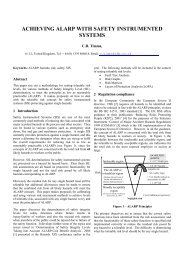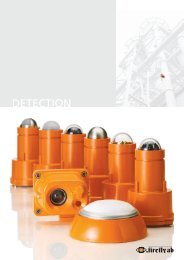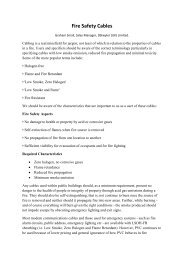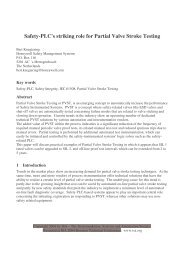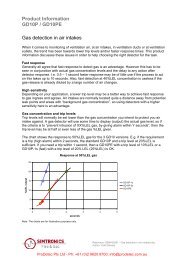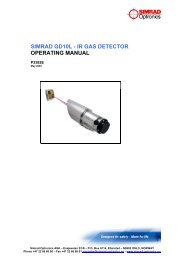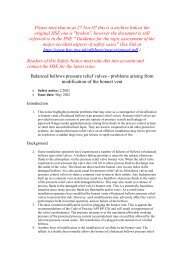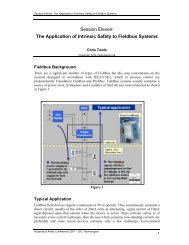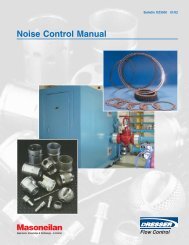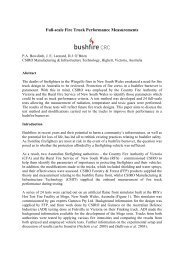Control Valve Technical Specification - ICEWeb
Control Valve Technical Specification - ICEWeb
Control Valve Technical Specification - ICEWeb
You also want an ePaper? Increase the reach of your titles
YUMPU automatically turns print PDFs into web optimized ePapers that Google loves.
<strong>Control</strong> <strong>Valve</strong> <strong>Technical</strong> <strong>Specification</strong><strong>Control</strong> <strong>Valve</strong><strong>Technical</strong> <strong>Specification</strong>Reference:“<strong>Control</strong> <strong>Valve</strong>s – Practical Guides for Measurementand <strong>Control</strong>” edited by Guy Borden, Jr. and Paul G.Friedmann, 1998 edition published by ISA.
<strong>Control</strong> <strong>Valve</strong> <strong>Technical</strong> <strong>Specification</strong>© 2000 by CCI. All Rights Reserved. This document has been produced by <strong>Control</strong> ComponentsIncorporated, Rancho Santa Margarita, California based on subjects presented in the ISA Guide "<strong>Control</strong><strong>Valve</strong>s - Practical Guides for Measurement and <strong>Control</strong>" edited by Guy Borden, Jr. and Paul G. Friedmann,1998 edition published by ISA and other published sources. The use of the letters ISA in thisspecification does not constitute an endorsement of this specification by the InstrumentSociety of America.
<strong>Control</strong> <strong>Valve</strong><strong>Technical</strong> <strong>Specification</strong>3 ReferencesThe selection of material and equipment, and the design and construction of theequipment covered by this specification shall comply with the applicable edition ofthe references in effect at the time of the Purchase Order and as notedthroughout this specification.3.1 The International Society for Measurement and <strong>Control</strong>ISA GuideISA S20.50ISA S75.01ISA S75.05ISA S75.11ISA SP75.17ISA RP75.23<strong>Control</strong> <strong>Valve</strong>s, Practical Guides for Measurement and <strong>Control</strong><strong>Specification</strong> Forms for Process Measurement and <strong>Control</strong>Instruments, Primary Elements and <strong>Control</strong> <strong>Valve</strong>sFlow Equations for Sizing <strong>Control</strong> <strong>Valve</strong>s<strong>Control</strong> <strong>Valve</strong> TerminologyInherent Flow Characteristic and Rangeability of <strong>Control</strong> <strong>Valve</strong>s<strong>Control</strong> <strong>Valve</strong> Aerodynamic Noise PredictionConsiderations for Evaluating <strong>Control</strong> <strong>Valve</strong> Cavitation3.2 American Society of Mechanical EngineersASME B1.20.1 Pipe Threads, General Purpose (inch)ASME B16.5 Steel Pipe Flanges and Flanged FittingsASME B16.10 Face-to-Face and End-to-End Dimensions of <strong>Valve</strong>sASME B16.20 Ring-Joint Gaskets and Grooves for Steel Pipe FlangesASME B16.34 <strong>Valve</strong>s – Flanged, Threaded, and Welding EndASME B31.1 Power PipingASME B31.3 Chemical Plant and Petroleum Refinery PipingASME VIII Rules for Construction of Pressure Vessels – Division 13.3 Fluid <strong>Control</strong> InstituteFCI 70-2<strong>Control</strong> <strong>Valve</strong> Seat Leakage3.4 National Association for Corrosion <strong>Control</strong> (where applicable)NACE MR0175Sulfide Stress Cracking Resistant Metallic Materials forOil Field Equipment3.5 International Electrotechnical CommissionIEC 534-8-3<strong>Control</strong> <strong>Valve</strong> Aerodynamic Noise Prediction Method3.6 Manufacturer’s Standardization SocietyMSS-SP-61Pressure Testing of Steel <strong>Valve</strong>s3.7 TerminologyThe terminology and nomenclature used in ISA S75.05, “<strong>Control</strong> <strong>Valve</strong>Terminology”, and other ISA standards apply to this specification.6
<strong>Control</strong> <strong>Valve</strong> <strong>Technical</strong> <strong>Specification</strong>4 <strong>Control</strong> <strong>Valve</strong> ApplicationsSeller shall select control valve design based on the requirements of theapplication, process operating conditions, and this specification.4.1 ApplicationsApplications, common names and uses, and their key attributes covered underthis specification are defined in Chapter 12 of the ISA Guide, “<strong>Control</strong> <strong>Valve</strong>s,Practical Guides for Measurement and <strong>Control</strong>” and are summarized below:4.1.1 Process <strong>Control</strong>/Feed RegulationApplicationFlow <strong>Control</strong>Level <strong>Control</strong>Pressure <strong>Control</strong>Pressure ReductionFlow RegulationCommon Names and UsesFCV, ThrottlingLCV, Deareator, Heater DrainPCV, InjectionPRVFeed Regulator, Gas Regulatorpp.412-415Key attributes for process control/feed regulation applications are accuracy ofcontrol resulting from small signal changes, and high rangeability resultingfrom increased pressure differentials that exist across the control valveduring start-up, shutdown, and low-load process conditions. Seller shallselect control valves that meet these attributes.4.1.2 Continuous LetdownApplicationAttemperationBlowdownFlow <strong>Control</strong>ChokeLetdownLevel <strong>Control</strong>Pressure <strong>Control</strong>Pressure RegulationCommon Names and UsesSprayBDVFCV, Mixing, Steam SupplyInjection, Withdrawal, Re-InjectionRich Amine, Drum, DrainLCV, Flash Tank, Separator LCVPCV, Sootblower, Steam, ReducingPRV, Steam Supplypp.416-417The key attribute for continuous letdown applications is accuracy of control.Seller shall select control valves that meet this attribute.4.1.3 Intermittent LetdownApplicationAnti SurgeDumpAuxiliaryExtractionReliefBlowdownFlareStart-UpTurbine BypassInjectionLetdownCommon Names and UsesLoad RejectAtmospheric Dump, Condenser Dump,Overboard DumpAux. SteamGas Withdrawal, Cavern WithdrawalPRVBDV, Steam Vent, Gas VentGas to FlareBypassPRDSGas Injection, Steam InjectionDepressurizingpp.417-4197
<strong>Control</strong> <strong>Valve</strong><strong>Technical</strong> <strong>Specification</strong>Key attributes for intermittent letdown applications are tight shut-off and faststroke speeds. Seller shall select control valves that meet these attributes.4.1.4 Recirculationpp.420-422ApplicationAnti SurgeBypassRecirculationDumpReturnLetdownCommon Names and UsesCompressor Recycle, Spillback, Kickback, Surge <strong>Control</strong>Start-up, Vent, Turbine BypassMini-flow, Leak-off, BFP RecirculationOverboard DumpKey attributes for recirculation applications are tight shut-off, anti-cavitationand/or low noise trim, and pipe vibration elimination. Seller shall select controlvalves that meet these attributes.4.2 Process Operating Conditions4.2.1 Process Datapp.486-487For each control valve, Buyer shall specify the process data for the followingthree flow conditions as a minimum: Normal Flow Rate, Maximum Flow Rate,and Minimum Flow Rate.4.2.1.1 Normal Flow RateThis flow condition is generally referred to as the design flow or materialbalance flow.4.2.1.2 Maximum Flow RateThis flow condition shall be consistent with the plant or equipmentoperational maximum flow condition. The maximum flow condition isgenerally the governing case for required maximum Cv capacity.4.2.1.3 Minimum Flow RateThis flow condition shall be consistent with the plant turndownrequirement or equipment turndown capability. The minimum flowcondition generally subjects the control valve to the highest differentialpressure condition. The minimum flow conditions are generally thegoverning case for the required trim performance.Buyer shall also specify the minimum and normal flow conditions for controlvalve services identified with “normally no flow” as well as the required flowconditions during non-normal plant operating conditions such as start-up,venting, depressurizing, etc.Seller shall provide sizing calculations for all specified flow conditions.4.2.2 Data SheetsIndividual control valve specification requirements shall be specified by Buyerand/or Seller on ISA Form S20.50 data sheet (see Appendix A) or Seller’sequivalent.8
<strong>Control</strong> <strong>Valve</strong><strong>Technical</strong> <strong>Specification</strong>pp.112-1615.1.1.2 A linear trim and quick opening trim shall operate below 90%travel at maximum flow.The C vcapacity required to meet above criteria is referred to as “C vrequired”. The actual C vcapacity of the valve is referred to as the “C vselected”. Specific applications may require an over-sized C vcapacity,which shall be specified by the buyer.5.1.2 Piping Geometry Factor, FPFor valves mounted between pipe reducers or other pipe fittings, the calculatedvalve capacity shall be corrected for a decrease in valve capacity conformingto ISA S75.01. The piping geometry factors FP, control valve correction factor,calculated F LP and/or X TP factors shall be specified by the Seller.5.1.3 Body Size<strong>Control</strong> valve bodies with reduced trims shall be considered for applicationswith the following conditions:– Pressure drop in excess of 5170 kPa (750 psi)– Gas/vapor outlet velocities in excess of 0.3 Mach– High noise exceeding 85 dBA– Choked flow– Flashing exceeding 5% weight of liquid being vaporized– Erosive fluids– Future capacity increase is anticipatedIn all cases, the control valve nominal body size shall not exceed the nominalline size.p. 1075.1.4 Minimum RangeabilityThe installed rangeability (actual available rangeability) of each control valvein the process system shall meet all flow conditions specified. The specifiedminimum flow condition shall be fully controllable.5.2 <strong>Control</strong> <strong>Valve</strong> Design5.2.1 Minimum RatingThe valve shall be rated to meet the design pressure and design temperatureof the application according to an internationally recognized standard.For flanged valves, the valve body rating shall never be lower than the flangerating. The flange rating for valve bodies smaller than 16-inch nominal sizeshall be minimum ASME Class 300. Flange rating for valve bodies 16-inchnominal size and larger shall be minimum ASME Class 150.5.2.2 Materialspp.363-370<strong>Control</strong> valve body materials shall meet, or exceed, the requirements ofthe application. Body and trim materials shall meet the temperaturerequirements. NACE MR0175, “Sulfide Stress Cracking ResistantMetallic Materials for Oil Field Equipment” shall be applied for allmaterials in sour fluid services.10
<strong>Control</strong> <strong>Valve</strong> <strong>Technical</strong> <strong>Specification</strong>Trim materials shall be selected to withstand corrosion, erosion and wearunder severe service conditions. Material combinations shall be selected formaximum galling resistance. AISI 300- and 400- series stainless steel, orequivalent, shall be used as a minimum.pgs.394-398Hard facing or heat treating shall be applied to trim seating surfaces of valvesas per Seller’s recommendations, but as a minimum, they shall includeerosive applications, steam applications with pressure drop conditionsexceeding 350 kPa (50 psi) and applications with pressure drop conditionsexceeding 4000 kPa (580 psi).5.2.3 Flow DirectionFlow direction for liquid service applications shall be flow-to-close. Flowdirection for gas service applications should be flow-to-open.5.2.4 Trim Design<strong>Valve</strong> trim shall be of the quick-change type for ease of maintenance. No internalcomponents shall be screwed or welded into the valve bodies or bonnets. Trimshall be designed to provide equal pressurization around the plug in order tominimize vibration and prevent any potential for binding. Seller shall select controlvalve trim design that meets the requirements of this specification.p. 26Seller shall provide a minimum of five years experience with any proposedcontrol valve trim design.5.2.5 End ConnectionsEnd connections shall be specified by the Buyer.p. 4605.2.5.1 Flanged ConnectionsFlanged connections shall comply with ASME B16.5. Dimensions offlanges larger than 24” size shall comply with industry standard and shallbe specified by the Buyer. Raised face (RF) flanges shall be used forlines rated up to and including ASME Class 600 and up to a designtemperature of 480°C (900°F). The gasket contact surface of raised faceflanged valves up to and including ASME Class 600 ratings shall besmooth machine-finished.p. 322Ring joint (RTJ) flanges shall be used for lines rated ASME Class 900and above, and for design temperature conditions exceeding 480°C(900°F). Ring grooves shall comply with ASME B16.20.Unless otherwise noted, face-to-face dimensions of flanged valvesshould comply with ASME B16.10. Seller to advise face-to-facedimensions proposed.5.2.5.2 Butt-Weld ConnectionsDimensions of butt-weld connections shall comply with Buyer’s specification.11
<strong>Control</strong> <strong>Valve</strong><strong>Technical</strong> <strong>Specification</strong>5.2.6 Gaskets, Packing and Bonnetpp.401-403Body gaskets for temperatures below 230°C (450°F) shall be PTFE or equal.Over 230°C (450°F), a spiral-wound gasket, grafoil-type gasket, or equal, shallbe used. In all cases, valve gaskets for body/bonnet joints or bottom flangejoints shall be metal seal or spiral wound stainless steel with a non-asbestosor Teflon filler suitable for the operating and design conditions.PTFE V-ring packing shall be used for services up to 230°C (450°F). Above230°C (450°F), graphite or Seller’s recommended packing shall be used.pp.327-331A standard bonnet shall be specified for temperatures of 0°C to 230°C (-32°Fto 450°F). Above 230°C (450°F) and below 0°C (-32°F), an extended bonnetand/or special packing shall be considered. Seller’s recommendation shall beevaluated and followed when feasible.5.3 <strong>Control</strong> <strong>Valve</strong> Performance5.3.1 Noisepp.223-268The maximum noise level emission from a control valve manifold installation,including contributions from piping elbows and reducers, shall not exceed thefollowing limits for any specified operating condition.- 85 dBA for process control/feed regulation, continuous letdown,intermittent letdown daily service and recirculation daily service applications.- 90 dBA for infrequent letdown and recirculation applications.Noise shall be calculated in accordance with methodology outlined in ISASP75.17 and IEC 534-8-3 guidelines. The maximum noise levels arespecified in terms of equivalent continuous A-weighted Sound PressureLevels (SPL) with an upper tolerance of +0 dBA. Seller shall be required toinclude inaccuracies of their quoted noise levels and shall guarantee that thenoise emission from control valves, including upper tolerance, shall notexceed the above stated limits for any specified operating condition.<strong>Control</strong> valve noise shall be treated at the source except as noted below. Theprovision of low-noise multipath multi-stage trim designs is generally most costeffective.Diffusers, baffle plates and silencers, either inside the valve body ordownstream of the valve, shall not be permitted for the following applications:- Process control/feed regulation- Continuous letdown- Intermittent letdown in daily service- Recirculation in daily servicepp. 238For other applications, special attention shall be given to the limited flowrangeability of these devices (i.e., noise reduction from these devices isgenerally reduced at low flow conditions). Noise generated by diffusers ororifice plates shall be calculated by ISA SP75.17 or IEC 534-8-3 as aseparate system from the valve trim and included in the overall noise source.A maximum of 5 dBA credit may be used for the application of insulationfor noise reduction.12
<strong>Control</strong> <strong>Valve</strong> <strong>Technical</strong> <strong>Specification</strong>Seller shall submit detailed noise calculations with the proposal in accordancewith methodology outlined in ISA SP75.17 and IEC 534-8-3 guidelines. Thecalculation basis and results shall be shown for manual or computer calculations.Seller shall guarantee control valves supplied meet the above requirements.pp.235-2365.3.2 Vibration and Erosion LimitsProper control valve selection shall ensure that the required energy can bedissipated without exceeding the maximum vibration levels in the pipingsystem and without exceeding the wear properties of the trim material. Sellershall select control valve trim design that facilitates maximum reduction ofcontrol valve induced vibration and trim wear.pp.434-435<strong>Control</strong> valve vibration and trim erosion can be reduced by multi-stagemultipath trim designs. In order to minimize vibration, Seller shall selectcontrol valves based on Table 12.3 of the ISA Guide, “<strong>Control</strong> <strong>Valve</strong>s,Practical Guides for Measurement and <strong>Control</strong>” summarized below:5.3.2.1 Liquid Service ApplicationsThe design shall provide a sufficient number of discrete pressure dropstages to maintain the trim exit velocity below 30 m/sec (100 ft/sec) forsingle-phase liquids and 23 m/sec (75 ft/sec) for cavitating, flashing, and/or erosive services. Seller shall specify number of discreet pressure dropstages required and provide body and trim exit velocity calculations withproposal. The calculation basis and results shall be shown for manual orcomputer calculations.pp.437-4385.3.2.2 Gas Service ApplicationsThe design shall provide a sufficient number of discrete pressure dropstages to maintain the trim exit fluid velocity head (V h) below 480 kPa (70psia) for continuous or intermittent duty and 1030 kPa (150 psia) forinfrequent duty. <strong>Valve</strong> trim exit fluid velocity head shall be calculatedbased on ISA Guide, “<strong>Control</strong> <strong>Valve</strong>s, Practical Guides for Measurementand <strong>Control</strong>” as follows:Where:V h= Kinetic Energy = ρ oV o2/(2 g c)ρ o= valve trim exit fluid densityV o= valve trim exit fluid velocityg c= gravitational constant in unit of measurementSeller shall specify number of discreet pressure drop stagesrequired and provide body and trim exit fluid velocity headcalculations with proposal. The calculation basis and results shallbe shown for manual or computer calculations.13
<strong>Control</strong> <strong>Valve</strong><strong>Technical</strong> <strong>Specification</strong>5.3.3 Cavitation, Choked Flow and FlashingISA S75.01, the ISA Guide “<strong>Control</strong> <strong>Valve</strong>s, Practical Guides forMeasurement and <strong>Control</strong>”, and the Seller’s valve cavitation indexdata shall be used for determining the severity of cavitation, chokedflow, or flashing conditions in the control valves. Seller shall providea control valve that eliminates cavitation damage.p. 191The design of valves in cavitation and flashing service shall be based onChapter 7 of the ISA Guide, “<strong>Control</strong> <strong>Valve</strong>s, Practical Guides for Measurementand <strong>Control</strong>” and include the following techniques for Cavitation-Resistant<strong>Valve</strong>s:– Reduce the pressure in multiple stages– Direct flow away from the valve body and pipe walls– Break the flow into many small streams– Force the flow through multiple turns or tortuous pathsp. 438pp.185-186The design shall provide a sufficient number of discrete pressure dropstages to maintain the trim exit velocity below 23 m/sec (75 ft/sec) forcavitating and flashing service. Seller shall specify number of discreetpressure drop stages required and provide body and trim exit velocitycalculations with Seller’s proposal. For multi-constituent fluids, specialconsideration shall be given to the potential for cavitation of the minorcomponents in the fluid.Contingencies on the minimum required control valve cavitation indexshall be applied to compensate for inaccuracies in process data andinaccuracies in Seller’s control valve cavitation index data. Buyershall carefully evaluate Seller’s selection of a control valve that eliminatescavitation.5.3.4 Flow CharacteristicSeller shall select the control valve flow characteristic to meet therangeability requirements as defined in Section 5.1.4, MinimumRangeability, and to provide stable control over the required range ofoperating conditions. Seller should select the control valve flowcharacteristic specified in the control valve data sheets.6 Actuator Selection6.1 Actuator Systemsp. 101Seller shall be responsible for correctly sizing the actuators based on the processoperating conditions and this technical specification. Actuator systems should bepneumatic type, either diaphragm or double-acting piston. For applications withvalve bodies greater than 2-inch nominal size and pressure drop in excess of4000 kPa (580 psi), diaphragm actuators shall not be applied. Air supply systemdesign pressure conditions are generally 930 kPag (135 psig) or less.<strong>Control</strong> valve actuator systems other than pneumatic shall be applied on anexception basis only. For actuator systems other than pneumatic type, Sellershall submit a request to deviate in writing to the Buyer.14
<strong>Control</strong> <strong>Valve</strong> <strong>Technical</strong> <strong>Specification</strong>6.2 Materials6.2.1 Actuator CylindersMaterials of the pneumatic actuators shall be suitable for the application andthe operating environment.6.2.2 Pneumatic Tubing, <strong>Valve</strong>s, and FittingsMaterials of the pneumatic tubing, valves, and fittings, which are to besupplied by the control valve Seller, shall be a minimum of AISI 316 stainlesssteel. Carbon steel, copper, bronze, brass, and AISI 304 stainless steelmaterials shall not be used on a control valve and actuator assembly. Airtubing, fitting or connection nipple sizes shall not be less than ¼” NPT.6.3 Performance6.3.1 <strong>Valve</strong> Travel Position AccuracyThe total maximum inaccuracy of the valve travel position due to any limitation(i.e., repeatability, deadband, resolution, hysteresis, etc.) shall be less than 2.0%.6.3.2 StabilityIn modulation, no more than one overshoot greater than 2.0% shall beobserved during shop performance and field-testing. Seller shall submittest reports with proposal showing performance curve of previousexperience with the same specification.6.3.3 Fail PositionAir failure position shall be accomplished without the aid of process pressureconditions. Air failure position shall be testable during inspection and duringplant commissioning when piping systems are de-pressurized.When an internal spring return feature can not achieve the failure mode of apiston actuator, piston actuators shall be equipped with a fail-safe trip system.Boosters may be applied, as required, to meet actuator stroke responserequirements on large or fast control signal changes.6.3.4 Stroke Speed RequirementsSeller shall select control valve and actuator assembly to achieve the strokespeed requirements specified on the process data sheets.All applications need to be verified for the actual stroke speedrequirements. Stroke times shall be tested on a 100% control signal stepchange without the aid of process pressure conditions. Stroke times shallbe tested during Seller’s inspection. Seller shall document the test criteriaand results of the functional tests performed during Seller’s inspection toverify operability and stroke speed. Boosters may be applied to meetstroke time requirements, but stroke movements shall remain stable at20%, 50%, and 80% control signal step changes.p. 470Fast stroke time requirements under failure conditions shall be separatelyspecified. Seller may use quick-exhaust valves, provided that they do notinterfere with the normal control operation of the actuator system.15
<strong>Control</strong> <strong>Valve</strong><strong>Technical</strong> <strong>Specification</strong>6.4 Actuator YokeYoke assemblies shall be cast or welded. Bolted yoke assemblies shall not beapplied. Yoke assemblies shall be designed such that it will accept installation ofall accessories needed to meet the requirements of the specified application.7 Accessories7.1 Positioners and Electro-Pneumatic (I/P) Transducerspp.495-5047.1.1 <strong>Valve</strong> positioners shall be provided with gauges to indicatesupply pressure, control air signal, and positioner output pressure.7.1.2 Electro-pneumatic valve positioners and pneumatic valvepositioners with integral electro-pneumatic transducers shall not be usedin potentially vibrating service conditions. The I/P transducer shall thenbe mounted separately from the valve and actuator assembly.7.1.3 The total maximum inaccuracy of the signal conversion in I/Ps, orelectro-pneumatic valve positioners, due to any limitation (i.e., repeatability,deadband, resolution, hysteresis, etc.), shall be less than 2.0%.7.2 HandwheelsWhen handwheels are specified, handwheel installations shall meet thefollowing requirements:– Neutral position shall be clearly indicated.– Handwheel mechanism shall not add friction to the actuator.– Maximum rim pull should be a maximum of 23 kgf (50 lbf).7.3 Limit SwitchesLimit switches shall be actuated by a mechanical switch or proximitysensor. Limit switch enclosures shall be hermetically sealed. Switchcontact outputs shall be at minimum, Single-Pole, Double-Throw (SPDT).7.4 Volume Tanks7.4.1 Minimum RatingVolume tanks shall be mechanically designed to withstand a minimumpressure of 930 kPag (135 psig). Volume tanks shall be manufactured inaccordance with ASME VIII. Div. 1 (stamped UM) requirements, or equivalent.7.4.2 SizingVolume tanks shall have a minimum capacity for two complete strokeoperations of the control valve at the minimum available instrument airpressure of 415 kPag (60 psig). The I/P transducer shall also be suppliedfrom this volume tank.16
<strong>Control</strong> <strong>Valve</strong> <strong>Technical</strong> <strong>Specification</strong>7.5 Position Indication7.5.1 <strong>Valve</strong> Position IndicatorEach control valve shall be provided with a valve position indicator. Theindication pointer shall be directly connected to the stem or shaft. The valveposition shall be indicated on a reversible scale with clearly graduatedmarkings at 25% valve opening position intervals and the words OPEN andCLOSED at the valve travel limits.7.5.2 <strong>Valve</strong> Position TransmitterAn electronic travel position transmitter, either separate or integral to thepositioner, providing a proportional valve stem or shaft position signal, shallbe specified when required for remote valve position indication.7.6 Marking and Identification7.6.1 MarkingThe direction of flow shall be cast or steel-stamped on the valve body, oralternatively, a stainless steel arrow shall be permanently fixed to the body byrivets or screws, for all appropriate valves that have been designed orselected for a specific flow direction.p.6677.6.2 IdentificationStainless Steel nameplates shall be provided for all control valves.Nameplates shall be permanently fastened to the valve by rivets or screws.8 Documentation RequirementsDocumentation requirements to be submitted by the Seller are indicatedthroughout this specification. As a minimum, documentation submitted by theSeller shall include the following:8.1 For Gas Service Applications8.1.1 Capacity (C v) as a function of travel; confirmation by the Seller that therequired rangeability can be met with the proposed control valve.8.1.2 Noise calculations, including calculation basis and results, for eachspecified flow condition; the Seller shall specify the maximum totalinaccuracy (i.e., tolerance expressed in ±dBA for each noise calculation) andshall add this to his calculated noise level.8.1.3 Body and trim exit fluid velocity head calculations, including number ofdiscreet pressure drop stages required, for each specified flow condition;Seller to also specify body and trim exit fluid velocities expressed in sonicvelocity (Mach number).17
<strong>Control</strong> <strong>Valve</strong><strong>Technical</strong> <strong>Specification</strong>8.2 For Liquid Service Applications8.2.1 Capacity (C v) as a function of travel; confirmation by the Seller that therequired rangeability can be met with the proposed control valve.8.2.2 Noise calculations, including calculation basis and results, foreach specified flow condition; the Seller shall specify the maximum totalinaccuracy (i.e., tolerance expressed in ±dBA for each noise calculation)and shall add this to his calculated noise level.8.2.3 Cavitation index data and choked flow parameter data both as afunction of travel specific for the selected control valve and application.The Seller shall confirm in writing that the selected control valveeliminates cavitation damage.8.2.4 Size Scale Effect (SSE) and Pressure Scale Effect (PSE) correctiondata for the cavitation index data.8.2.5 Body and trim exit fluid velocity calculations, including number ofdiscreet pressure drop stages required, for each specified flow condition.8.3 For All Applications8.3.1 Actuator load calculations for each control valve.8.3.2 Prior test reports of actuator performance stability showingperformance curve of previous experience with the same specification.8.3.3 Seller’s hydrostatic test report for each control valve.8.3.4 Seller’s seat leakage test report for each control valve.8.3.5 Seller’s stroke performance test report for each control valve.8.3.6 Certified Material Test Reports for each control valve.18
<strong>Control</strong> <strong>Valve</strong> <strong>Technical</strong> <strong>Specification</strong>19




